

Compact Muon Solenoid
LHC, CERN
| CMS-HIG-23-007 ; CERN-EP-2024-123 | ||
| Study of WH production through vector boson scattering and extraction of the relative sign of the W and Z couplings to the Higgs boson in proton-proton collisions at $ \sqrt{s} = $ 13 TeV | ||
| CMS Collaboration | ||
| 26 May 2024 | ||
| Phys. Lett. B 860 (2025) 139202 | ||
| Abstract: A search for the production of a W boson and a Higgs boson through vector boson scattering (VBS) is presented, using CMS data from proton-proton collisions at $ \sqrt{s} = $ 13 TeV collected from 2016 to 2018. The integrated luminosity of the data sample is 138 fb$ ^{-1} $. Selected events must be consistent with the presence of two jets originating from VBS, the leptonic decay of the W boson to an electron or muon, and a Higgs boson decaying into a pair of b quarks, reconstructed as either a single merged jet or two resolved jets. A measurement of the process as predicted by the standard model (SM) is performed alongside a study of beyond-the-SM (BSM) scenarios. The SM analysis sets an observed (expected) 95% confidence level upper limit of 14.3 (9.0) on the ratio of the measured VBS WH cross section to that expected by the SM. The BSM analysis, conducted within the so-called $ \kappa $ framework, excludes all scenarios with $ \lambda_{\mathrm{W}\mathrm{Z}} < $ 0 that are consistent with current measurements, where $ \lambda_{\mathrm{W}\mathrm{Z}} = \kappa_{\mathrm{W}}/\kappa_{\mathrm{Z}} $ and $ \kappa_{\mathrm{W}} $ and $ \kappa_{\mathrm{Z}} $ are the HWW and HZZ coupling modifiers, respectively. The signficance of the exclusion is beyond 5 standard deviations, and it is consistent with the SM expectation of $ \lambda_{\mathrm{W}\mathrm{Z}} = $ 1. | ||
| Links: e-print arXiv:2405.16566 [hep-ex] (PDF) ; CDS record ; inSPIRE record ; HepData record ; CADI line (restricted) ; | ||
| Figures & Tables | Summary | Additional Figures | References | CMS Publications |
|---|
| Figures | |

png pdf |
Figure 1:
Tree-level Feynman diagrams for the production of $ \mathrm{W}\mathrm{H}\to\ell\nu\mathrm{b}\overline{\mathrm{b}} $ via VBS, where $ \ell $ is an electron or muon. |

png pdf |
Figure 1-a:
Tree-level Feynman diagrams for the production of $ \mathrm{W}\mathrm{H}\to\ell\nu\mathrm{b}\overline{\mathrm{b}} $ via VBS, where $ \ell $ is an electron or muon. |
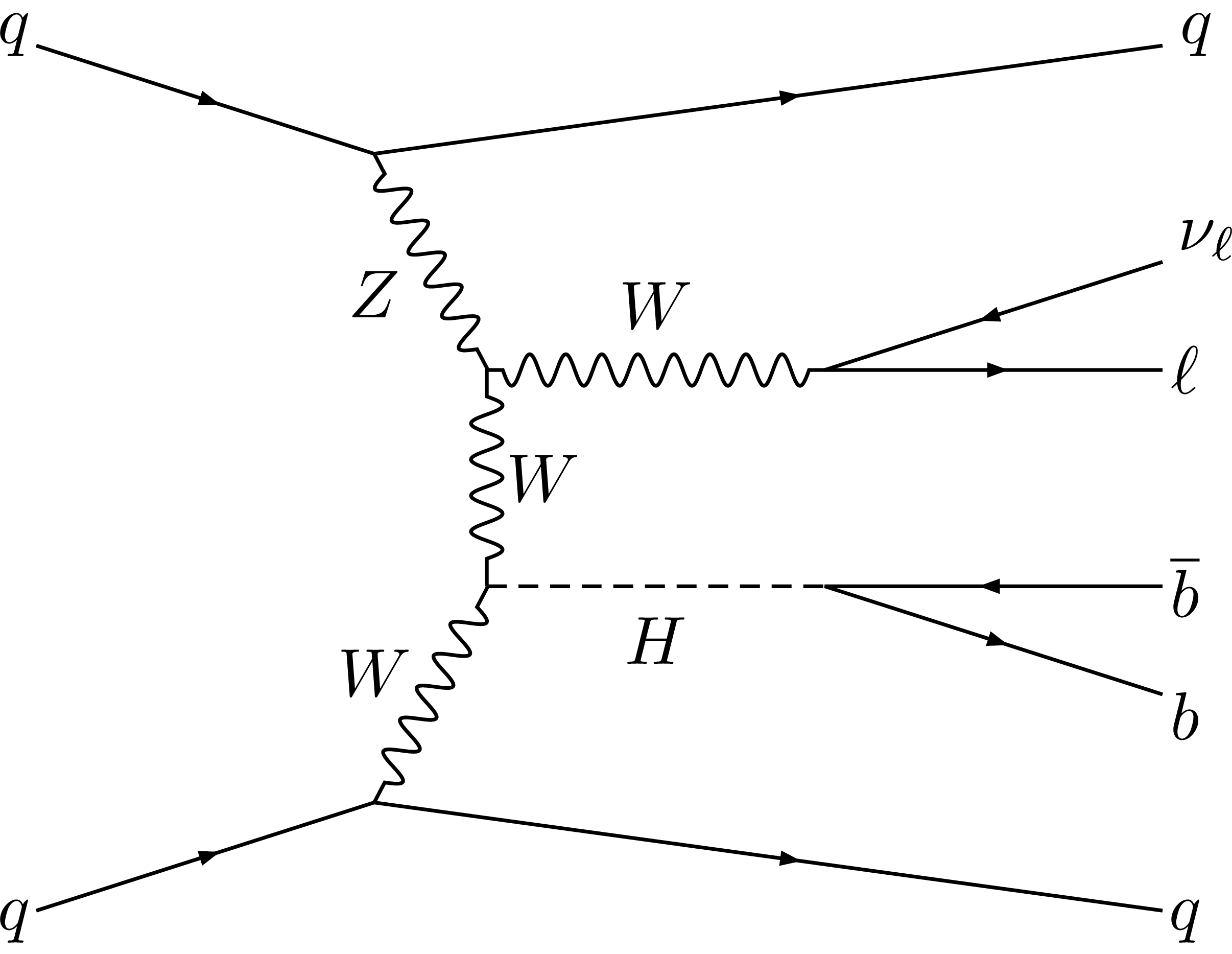
png pdf |
Figure 1-b:
Tree-level Feynman diagrams for the production of $ \mathrm{W}\mathrm{H}\to\ell\nu\mathrm{b}\overline{\mathrm{b}} $ via VBS, where $ \ell $ is an electron or muon. |

png pdf |
Figure 1-c:
Tree-level Feynman diagrams for the production of $ \mathrm{W}\mathrm{H}\to\ell\nu\mathrm{b}\overline{\mathrm{b}} $ via VBS, where $ \ell $ is an electron or muon. |
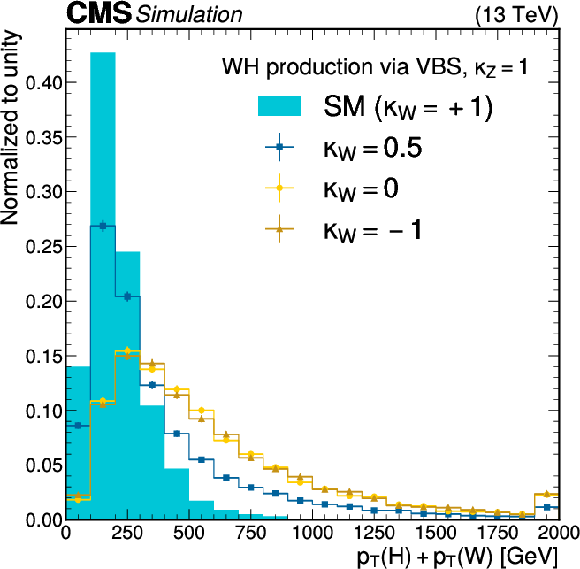
png pdf |
Figure 2:
Distributions of the scalar sum of the Higgs boson and W boson $ p_{\mathrm{T}} $, as generated by MADGRAPH, for simulated signal events with $ \kappa_{\mathrm{Z}}= $ 1 and the following $ \kappa_{\mathrm{W}} $ values: $ \kappa_{\mathrm{W}}= $ 1 (SM) in light blue (filled), $ \kappa_{\mathrm{W}}= $ 0.5 in dark blue, $ \kappa_{\mathrm{W}}= $ 0 in yellow, and $ \kappa_{\mathrm{W}}=- $1 in gold. The highest bin also contains the overflows. |

png pdf |
Figure 3:
Event yields observed in the data (black points) for regions A, B, C, and D of the BSM analysis, where region A is the signal region. The simulated SM background event yields in the control regions B, C, and D are shown in light blue. The background in the signal region estimated from data in regions B, C, and D is plotted in dark blue. The lower panel shows the ratio of the data to the estimated background yields. The vertical bars on the points give the statistical uncertainty in the data, while the gray and hatched areas represent the statistical and total uncertainties in the estimated backgrounds, respectively. |

png pdf |
Figure 4:
Observed and expected distributions of the BDT output in the signal region of the SM analysis. The data are shown by the points and the expected contributions from the various sources after the fit to the data by the colored histograms. The lower plot displays the ratio of the data to the sum of the predicted distributions. The vertical bars on the points indicate the statistical uncertainty in the data, and the hatched regions show the systematic uncertainty in the sum of the predicted yields. The rightmost bin includes overflow. |
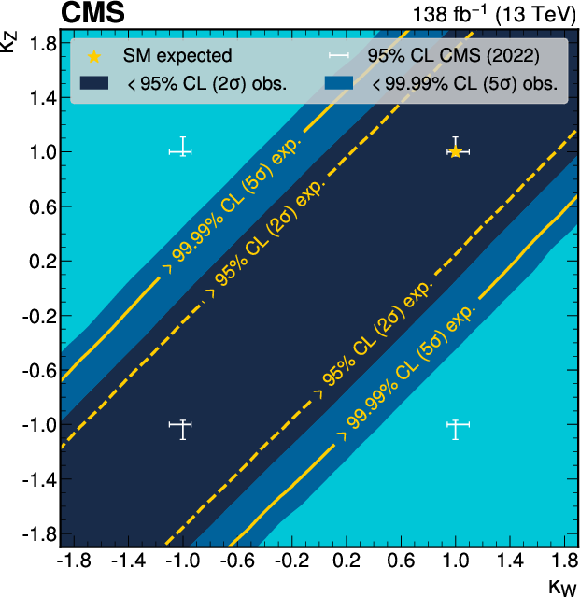
png pdf |
Figure 5:
The $ > $95% (2$ \,\sigma $) and $ > $99.99% (5$ \,\sigma $) exclusion regions in the two-dimensional $ \kappa_{\mathrm{W}}-\kappa_{\mathrm{Z}} $ plane are shown by the dark and light blue colors, respectively. Previous CMS measurements of the magnitude of $ \kappa_{\mathrm{W}} $ and $ \kappa_{\mathrm{Z}} $ at the 95% CL [8] are represented by the horizontal and vertical bars, and the SM expectation is given by the gold star. |
| Tables | |

png pdf |
Table 1:
The background yield estimated from data and signal yield ($ \kappa_{\mathrm{W}}=- $1, $ \kappa_{\mathrm{Z}}= $ 1) predicted by MC simulation in the BSM signal region are shown with their associated statistical and systematic uncertainties. The systematic uncertainty in the signal yield quoted here is the sum in quadrature of the independent relative systematic uncertainties, multiplied by the total yield. The observed data yield is also tabulated. |
| Summary |
| In this Letter, we have reported the first study of WH production through vector boson scattering (VBS) using 138 fb$ ^{-1} $ of data recorded with the CMS detector at the LHC between 2016 and 2018 at a center-of-mass energy of 13 TeV. We focused on both the standard model (SM) scenario and scenarios where $ \lambda_{\mathrm{W}\mathrm{Z}}=\kappa_{\mathrm{W}}/\kappa_{\mathrm{Z}} $, with $ \kappa_{\mathrm{W}} $ and $ \kappa_{\mathrm{Z}} $ being the HWW and HZZ coupling modifiers, respectively, is modified from the SM value of 1. Events were selected by requiring exactly one isolated charged lepton (electron or muon) and the magnitude of the missing transverse momentum $ p_{\mathrm{T}}^\text{miss} $ being consistent with the W boson leptonic decay, two jets consistent with a VBS interaction, and one or two additional jets consistent with the Higgs boson decay to $ \mathrm{b} \overline{\mathrm{b}} $. Assuming a signal with SM features, the observed (expected) ratio between the measured rate of VBS WH and the expectation from the SM is 3.0 $ ^{+5.9}_{-5.5} $ (1.0$^{+4.3}_{-4.0}$), corresponding to an observed (expected) 95% confidence level upper limit of 14.3 (9.0) times the SM prediction. The BSM scenario where $ \lambda_{\mathrm{W}\mathrm{Z}} = - $1, with $ |\kappa_{\mathrm{W}}| = |\kappa_{\mathrm{Z}}| = $ 1, and all the opposite-sign scenarios with $ \kappa_{\mathrm{W}} $ and $ \kappa_{\mathrm{Z}} $ values compatible with the current measurements are excluded with a significance greater than 5 standard deviations, corresponding to a confidence level higher than 99.99%. |
| Additional Figures | |

png pdf |
Additional Figure 1:
A scan of $ -2\Delta\ln{L} $, where $ L $ is the likelihood, for the SM analysis plotted as a function of the signal strength $ \mu $ for the expected (red) and the observed (black) data. |

png pdf |
Additional Figure 2:
Observed and expected distributions of the VBS dijet mass in the $ \mathrm{t} \overline{\mathrm{t}} $ control region of the SM analysis. The data are shown by the points and the expected contributions from the various sources after the fit to the data by the colored histograms. The lower plot displays the ratio of the data to the sum of the predicted distributions. The vertical bars on the points indicate the statistical uncertainty in the data, and the hatched regions show the systematic uncertainty in the sum of the predicted yields. |
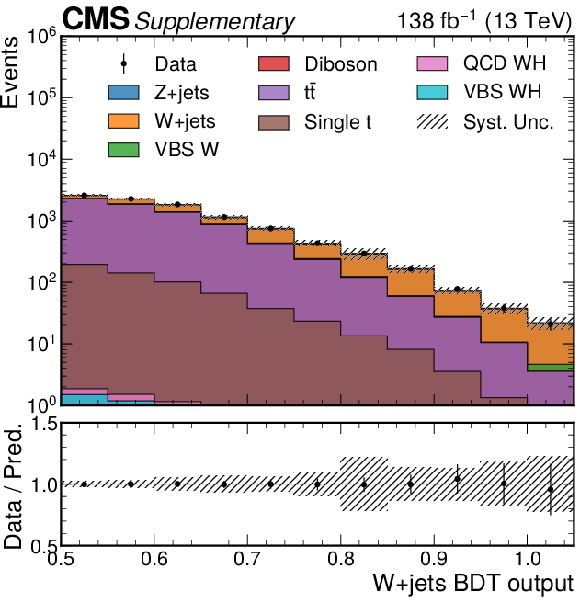
png pdf |
Additional Figure 3:
Observed and expected distributions of the W$+$jets BDT output in the W$+$jets control region of the SM analysis. The data are shown by the points and the expected contributions from the various sources after the fit to the data by the colored histograms. The lower plot displays the ratio of the data to the sum of the predicted distributions. The vertical bars on the points indicate the statistical uncertainty in the data, and the hatched regions show the systematic uncertainty in the sum of the predicted yields. |

png pdf |
Additional Figure 4:
A scan of $ -2\Delta\ln{L} $, where $ L $ is the likelihood, for the BSM analysis plotted as a function of the signal strength $ \mu $ for the observed data, with the $ \mu $ values excluded at the 68% $ \text{CL} (1\,\sigma) $ labeled. |
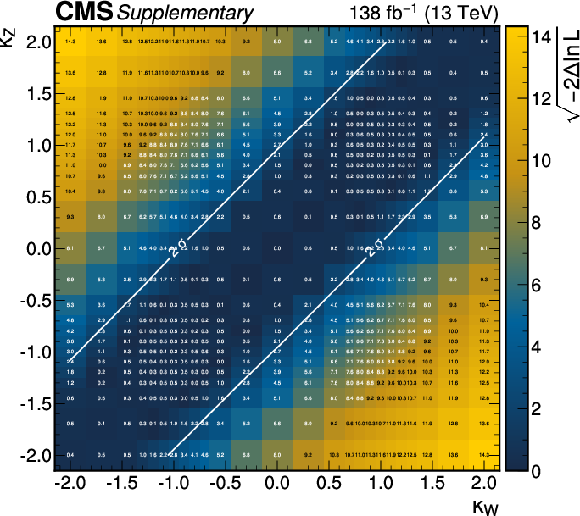
png pdf |
Additional Figure 5:
The exclusion significance in the BSM analysis for $ \mu = $ 1, where $ \mu $ is the signal strength, plotted as a function of $ \kappa_{\mathrm{W}} $ and $ \kappa_{\mathrm{Z}} $ with the 2 $ \,\sigma $ contour boundary overlaid. |

png pdf |
Additional Figure 6:
The $ M_{\mathrm{SD}} $ distribution for the BSM analysis in region A ($ M_{\mathrm{SD}} < $ 150 GeV) and region D ($ M_{\mathrm{SD}} \geq $ 150 GeV). The signal, with $ \kappa_{\mathrm{W}} = - $1 and $ \kappa_{\mathrm{Z}} = + $1, is plotted in red. |

png pdf |
Additional Figure 7:
The $ M_{\mathrm{SD}} $ distribution for the BSM analysis in region B ($ M_{\mathrm{SD}} < $ 150 GeV) and region C ($ M_{\mathrm{SD}} \geq $ 150 GeV). The signal, with $ \kappa_{\mathrm{W}} = - $1 and $ \kappa_{\mathrm{Z}} = + $1, is plotted in red. |
| References | ||||
| 1 | F. Englert and R. Brout | Broken symmetry and the mass of gauge vector mesons | PRL 13 (1964) 321 | |
| 2 | P. W. Higgs | Broken symmetries, massless particles and gauge fields | PL 12 (1964) 132 | |
| 3 | P. W. Higgs | Broken symmetries and the masses of gauge bosons | PRL 13 (1964) 508 | |
| 4 | G. S. Guralnik, C. R. Hagen, and T. W. B. Kibble | Global conservation laws and massless particles | PRL 13 (1964) 585 | |
| 5 | P. W. Higgs | Spontaneous symmetry breakdown without massless bosons | PR 145 (1966) 1156 | |
| 6 | T. W. B. Kibble | Symmetry breaking in non-Abelian gauge theories | PR 155 (1967) 1554 | |
| 7 | LHC Higgs Cross Section Working Group | Higgs properties: Report of the LHC Higgs Cross Section Working Group | in Handbook of LHC Higgs Cross Sections, CERN Yellow Reports: Monographs. 201 (1900) 3 |
1307.1347 |
| 8 | CMS Collaboration | A portrait of the Higgs boson by the CMS experiment ten years after the discovery | Nature 607 (2022) 60 | CMS-HIG-22-001 2207.00043 |
| 9 | ATLAS Collaboration | A detailed map of Higgs boson interactions by the ATLAS experiment ten years after the discovery | Nature 607 (2022) 52 | 2207.00092 |
| 10 | D. Stolarski and Y. Wu | Tree-level interference in vector boson fusion production of Vh | PRD 102 (2020) 033006 | 2006.09374 |
| 11 | CMS Collaboration | The CMS experiment at the CERN LHC | JINST 3 (2008) S08004 | |
| 12 | CMS Collaboration | HEPData record for this analysis | link | |
| 13 | CMS Collaboration | Development of the CMS detector for the CERN LHC Run 3 | JINST 19 (2024) P05064 | CMS-PRF-21-001 2309.05466 |
| 14 | CMS Collaboration | Performance of the CMS Level-1 trigger in proton-proton collisions at $ \sqrt{s} = $ 13 TeV | JINST 15 (2020) P10017 | CMS-TRG-17-001 2006.10165 |
| 15 | CMS Collaboration | The CMS trigger system | JINST 12 (2017) P01020 | CMS-TRG-12-001 1609.02366 |
| 16 | CMS Collaboration | Electron and photon reconstruction and identification with the CMS experiment at the CERN LHC | JINST 16 (2021) P05014 | CMS-EGM-17-001 2012.06888 |
| 17 | CMS Collaboration | Performance of the CMS muon detector and muon reconstruction with proton-proton collisions at $ \sqrt{s}= $ 13 TeV | JINST 13 (2018) P06015 | CMS-MUO-16-001 1804.04528 |
| 18 | CMS Collaboration | Description and performance of track and primary-vertex reconstruction with the CMS tracker | JINST 9 (2014) P10009 | CMS-TRK-11-001 1405.6569 |
| 19 | CMS Collaboration | Particle-flow reconstruction and global event description with the CMS detector | JINST 12 (2017) P10003 | CMS-PRF-14-001 1706.04965 |
| 20 | CMS Collaboration | Performance of reconstruction and identification of $ \tau $ leptons decaying to hadrons and $ \nu_\tau $ in pp collisions at $ \sqrt{s} = $ 13 TeV | JINST 13 (2018) P10005 | CMS-TAU-16-003 1809.02816 |
| 21 | CMS Collaboration | Jet energy scale and resolution in the CMS experiment in pp collisions at 8 TeV | JINST 12 (2017) P02014 | CMS-JME-13-004 1607.03663 |
| 22 | CMS Collaboration | Performance of missing transverse momentum reconstruction in proton-proton collisions at $ \sqrt{s} = $ 13 TeV using the CMS detector | JINST 14 (2019) P07004 | CMS-JME-17-001 1903.06078 |
| 23 | CMS Collaboration | Technical proposal for the Phase-II upgrade of the Compact Muon Solenoid | CMS Technical Proposal CERN-LHCC-2015-010, CMS-TDR-15-02, 2015 CDS |
|
| 24 | CMS Collaboration | Performance of electron reconstruction and selection with the CMS detector in proton-proton collisions at $ \sqrt{s}= $ 8 TeV | JINST 10 (2015) P06005 | CMS-EGM-13-001 1502.02701 |
| 25 | M. Cacciari, G. P. Salam, and G. Soyez | FastJet user manual | EPJC 72 (2012) 1896 | 1111.6097 |
| 26 | M. Cacciari, G. P. Salam, and G. Soyez | The anti-$ k_{\mathrm{T}} $ jet clustering algorithm | JHEP 04 (2008) 063 | 0802.1189 |
| 27 | CMS Collaboration | Pileup mitigation at CMS in 13 TeV data | JINST 15 (2020) P09018 | CMS-JME-18-001 2003.00503 |
| 28 | CMS Collaboration | Identification of heavy-flavour jets with the CMS detector in pp collisions at 13 TeV | JINST 13 (2018) P05011 | CMS-BTV-16-002 1712.07158 |
| 29 | E. Bols et al. | Jet flavour classification using DeepJet | JINST 15 (2020) P12012 | 2008.10519 |
| 30 | CMS Collaboration | Performance of the DeepJet b tagging algorithm using 41.9/fb of data from proton-proton collisions at 13 TeV with phase 1 CMS detector | CMS Detector Performance Summary CMS-DP-2018-058, 2018 CDS |
|
| 31 | H. Qu and L. Gouskos | ParticleNet: Jet tagging via particle clouds | PRD 101 (2020) 056019 | 1902.08570 |
| 32 | A. J. Larkoski, S. Marzani, G. Soyez, and J. Thaler | Soft drop | JHEP 05 (2014) 146 | 1402.2657 |
| 33 | M. Dasgupta, A. Fregoso, S. Marzani, and G. P. Salam | Towards an understanding of jet substructure | JHEP 09 (2013) 029 | 1307.0007 |
| 34 | J. Alwall et al. | The automated computation of tree-level and next-to-leading order differential cross sections, and their matching to parton shower simulations | JHEP 07 (2014) 079 | 1405.0301 |
| 35 | T. Sjöstrand et al. | An introduction to PYTHIA 8.2 | Comput. Phys. Commun. 191 (2015) 159 | 1410.3012 |
| 36 | S. Frixione, P. Nason, and G. Ridolfi | A positive-weight next-to-leading-order Monte Carlo for heavy flavour hadroproduction | JHEP 09 (2007) 126 | 0707.3088 |
| 37 | P. Nason | A new method for combining NLO QCD with shower Monte Carlo algorithms | JHEP 11 (2004) 040 | hep-ph/0409146 |
| 38 | S. Frixione, P. Nason, and C. Oleari | Matching NLO QCD computations with parton shower simulations: the POWHEG method | JHEP 11 (2007) 070 | 0709.2092 |
| 39 | S. Alioli, P. Nason, C. Oleari, and E. Re | A general framework for implementing NLO calculations in shower Monte Carlo programs: the POWHEG BOX | JHEP 06 (2010) 043 | 1002.2581 |
| 40 | J. Alwall et al. | Comparative study of various algorithms for the merging of parton showers and matrix elements in hadronic collisions | EPJC 53 (2008) 473 | 0706.2569 |
| 41 | R. Frederix and S. Frixione | Merging meets matching in MC@NLO | JHEP 12 (2012) 061 | 1209.6215 |
| 42 | E. Re | Single-top Wt-channel production matched with parton showers using the POWHEG method | EPJC 71 (2011) 1547 | 1009.2450 |
| 43 | R. Frederix, E. Re, and P. Torrielli | Single-top $ t $-channel hadroproduction in the four-flavour scheme with POWHEG and aMC@NLO | JHEP 09 (2012) 130 | 1207.5391 |
| 44 | S. Alioli, P. Nason, C. Oleari, and E. Re | NLO single-top production matched with shower in POWHEG: $ s $- and $ t $-channel contributions | JHEP 09 (2009) 111 | 0907.4076 |
| 45 | G. Luisoni, P. Nason, C. Oleari, and F. Tramontano | HW$ ^{\pm} $/HZ + 0 and 1 jet at NLO with the POWHEG BOX interfaced to GoSam and their merging within MiNLO | JHEP 10 (2013) 083 | 1306.2542 |
| 46 | B. Cabouat and T. Sjöstrand | Some dipole shower studies | EPJC 78 (2018) 226 | 1710.00391 |
| 47 | CMS Collaboration | Extraction and validation of a new set of CMS PYTHIA8 tunes from underlying-event measurements | EPJC 80 (2020) 4 | CMS-GEN-17-001 1903.12179 |
| 48 | NNPDF Collaboration | Parton distributions for the LHC Run II | JHEP 04 (2015) 040 | 1410.8849 |
| 49 | NNPDF Collaboration | Parton distributions from high-precision collider data | EPJC 77 (2017) 663 | 1706.00428 |
| 50 | GEANT4 Collaboration | GEANT 4---a simulation toolkit | NIM A 506 (2003) 250 | |
| 51 | T. Chen and C. Guestrin | XGBoost: A scalable tree boosting system | in Proc. 22nd ACM SIGKDD Int. Conf. on Knowledge Discovery and Data Mining, KDD '16, Association for Computing Machinery, New York, 2016 link |
|
| 52 | CMS Collaboration | Search for supersymmetry in pp collisions at $ \sqrt{s} = $ 13 TeV with 137 fb$ ^{-1} $ in final states with a single lepton using the sum of masses of large-radius jets | PRD 101 (2020) 052010 | CMS-SUS-19-007 1911.07558 |
| 53 | CDF Collaboration | A measurement of $ \sigma {B} ({W} \to e \nu) $ and $ \sigma {B} ({Z}^0 \to e^+ e^-) $ in $ \bar{p}p $ collisions at $ \sqrt{s} = $ 1800 GeV | PRD 44 (1991) 29 | |
| 54 | Particle Data Group , R. L. Workman et al. | Review of particle physics | Prog. Theor. Exp. Phys. 2022 (2022) 083C01 | |
| 55 | CMS Collaboration | Precision luminosity measurement in proton-proton collisions at $ \sqrt{s} = $ 13 TeV in 2015 and 2016 at CMS | EPJC 81 (2021) 800 | CMS-LUM-17-003 2104.01927 |
| 56 | CMS Collaboration | CMS luminosity measurement for the 2017 data-taking period at $ \sqrt{s} = $ 13 TeV | CMS Physics Analysis Summary, 2018 link |
|
| 57 | CMS Collaboration | CMS luminosity measurement for the 2018 data-taking period at $ \sqrt{s} = $ 13 TeV | CMS Physics Analysis Summary, 2019 link |
|
| 58 | R. J. Barlow and C. Beeston | Fitting using finite Monte Carlo samples | Comput. Phys. Commun. 77 (1993) 219 | |
| 59 | ATLAS and CMS Collaborations | Measurements of the Higgs boson production and decay rates and constraints on its couplings from a combined ATLAS and CMS analysis of the LHC pp collision data at $ \sqrt{s}= $ 7 and 8 TeV | JHEP 08 (2016) 045 | 1606.02266 |

|
Compact Muon Solenoid LHC, CERN |

|

|

|

|

|

|